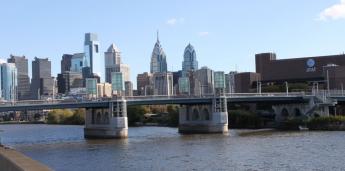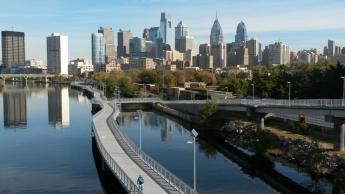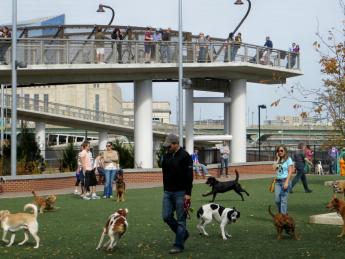Related Topics
Historical Preservation
The 20% federal tax credit for historic preservation is said to have been the special pet of Senator Lugar of Indiana. Much of the recent transformation of Philadelphia's downtown is attributed to this incentive.
Hidden River (2)

|
| South Street Bridge |
When the South Street bridge was reconstructed over the Schuylkill, it was just a bridge. When the Schuylkill around the Art Museum was dressed up for joggers and azalea fanciers, it was just an enhancement for the Museum. But now that the plans are announced for filling in the gaps, even a dumbell like me can see what's afoot to enhance and gentrify the whole Schuylkill, at least on the East side, and at least for the whole width of Center City. The river was once entirely industrial from Chestnut Hill to the Airport, and smoky railroads ran on both banks for at least half of that distance, so the city was a curious mixture of upscale housing right next to some pretty noisome industrial areas, right in the center of things. Now, you can tell at a glance that someone, somewhere has decided to beautify and gentrify the whole river. That's sort of turning the city inside out because for a long time the banks of Delaware were the elite place to live, and the Schuylkill was the hidden river, lined with noxious industrial pollution like an open sewer. As long as the politicians seem intent to put gambling casinos on the Delaware waterfront, that river's probably going to seem honky-tonk for a long time. But the Schuylkill, the hidden river, seems destined to be the place you take your friends. Violent city planning and redesign used to imply that Edmund Bacon was at work, but someone else has apparently replaced dear Edmund, without even claiming much credit for it. That isn't like what you would expect from architects, who tend to run around like rainmakers.

|
| South Street Bridge WalK |
It suddenly dawns on the whole city that there are plans afoot on a grand scale, like West Park in New York, or at least San Antonio, or maybe the Chicago River region, to transform Philadelphia's useless and decaying industrial area into the fashionable place to live. When the planned 1300 feet of remaining Schuylkill waterfront are next filled in, the whole Center City will have a new residential face. And indeed, the railroads and their marshaling yards mostly haven't been removed, since the hidden river is hidden because it is lined with hills which conceal the railroads until you are right on top of them. And another fortuitous circumstance is that railroads have been split apart into freight and passenger lines using the same rails. The passenger trains run during the day and the freight trains run at night, with the freight trains "side-lined", during the day, right in the center of town. You don't notice them much, because they sit down out of sight during daylight hours, and no one notices at night. The marshaling yards are too big to hide, but I understand the plan is to cover them over and build skyscrapers on top. That's fine with me, except for those stories you hear about condominium fights over who should pay for repairs of a jointly owned skyscraper. Maybe that's why apartment dwellers move to a new one every few years; maybe it's a gigantic game of hot potato, running until the music stops.

|
| Schuylkill River Dog Park |
In any event, the architects seem to be outdoing each other, designing townhouses with front and back garages, fronting on the river or fronting on the city park on the second story. And everybody using the dog parks. My goodness, there are several dog parks along the river, with zillions of little dogs running around. They seem to be having a wonderful time sniffing each other, and chasing balls. There are a few basketball courts, but no tennis courts are in sight; mostly, it's dog parks. The streets all seem to be running one-way the wrong way, but if you live there you are probably told the secret passage in, and the secret passage out. Everything else seems to be one-way, do not enter, but of course, that doesn't bother people who mainly want to walk their dogs. Imperceptibly, the new townhouses merge with the stately old townhouses, which as I recall once used the Baltimore and Ohio station in the area. The armory for the First City Troop is still there in the midst of the new revival, reminding folks of the days when the troopers brought their horses into town that way. In case you have forgotten, the city ordinance is that an out-of-control horse always has the right of way. Perhaps that could be re-asserted in some way to Pekinese and other toy dogs, too.
The big feature on display is the walkway, built right out over the water in the river for about five blocks. It takes some elaborate twists and turns to get over the sleeping freight trains on the railway below. But no doubt it builds big muscles to get over the hump, and maybe even discourages dogs from escaping to freedom.
Originally published: Monday, October 13, 2014; most-recently modified: Tuesday, May 21, 2019